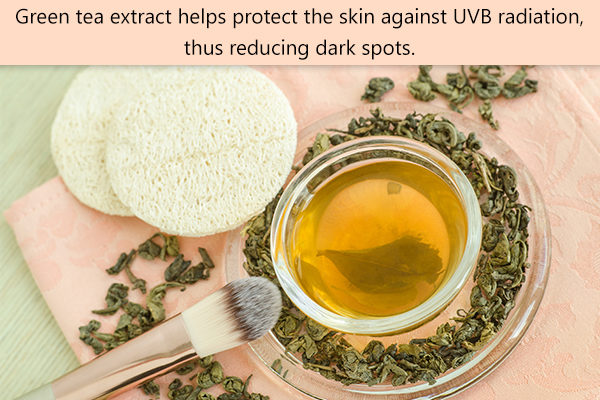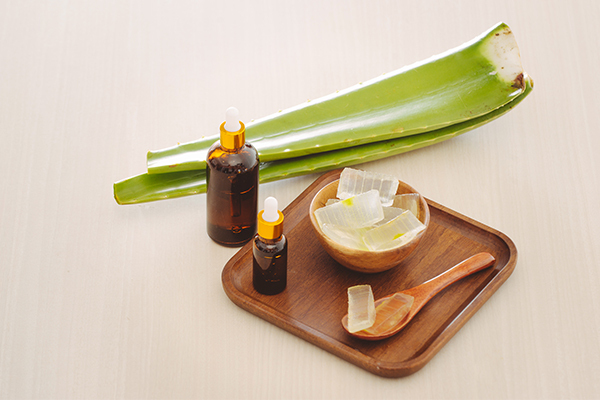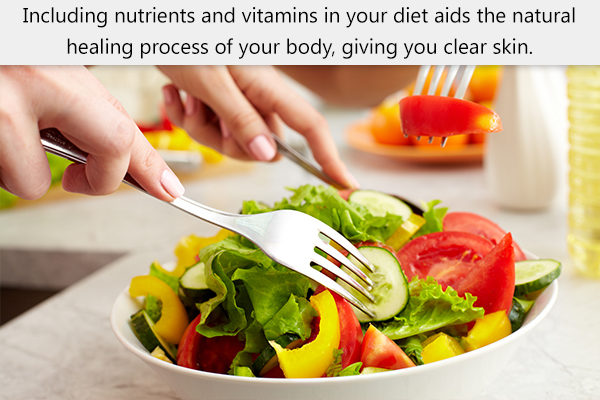In this article:
People, especially those with deeper skin tones, often struggle with dark spots or patches on their skin which can appear due to a variety of reasons. These blemishes can be stubborn or recurrent and are one of the most common complaints registered at dermatological clinics.

While the treatment for dark spots can vary depending upon the underlying cause, there are some tried-and-tested methods that can help fade the discoloration and make them less visible.
Home Remedies for Dark Spots
The following at-home treatments using natural ingredients can help prevent new dark spots and lighten the ones that are already present:
Note: Always do a patch test before trying any new ingredient on your face, since your facial skin is extra-sensitive and can react negatively.
1. Apply green tea

Daily consumption of green tea can help improve your overall skin health and appearance.
A study conducted in 2017 reported the efficacy of green tea polyphenols in reducing the severity of acne. (1)
Additionally, green tea extract helps protect the skin against UVB radiation, thus reducing dark spots. When combined with titanium and zinc oxide in sunscreen preparations, green tea extracts can help prevent skin damage caused by both UVA and UVB radiations. (2)
How to use:
- People with dark circles can place cool and damp green tea bags on the affected area for about 15 minutes to reduce the hyperpigmentation around their eyes.
- Prepare a spot removal face mask by mixing green tea, banana, and kiwi juice. Apply it for about 20 minutes and then wash it off with normal water.
Green tea is widely used for its anti-inflammatory and antioxidant properties that can help prevent the signs of aging, including wrinkles and age spots.
2. Include vitamin C in your skin care routine
Vitamin C can help stimulate the production and stabilization of collagen and can also aid in skin lightening.
A study conducted in 2016 highlighted the use of vitamin C or ascorbic acid in multiple cosmetic products chiefly for its ability to delay skin aging, correct skin discoloration, and ward off sun damage. (3)
A meta-analysis conducted in 2019 demonstrated that formulations with 10% vitamin C could act as a safe and effective derma cosmetic anti-pigmenting agent, which can also help prevent photoaging. (4)
How to use:
- There are many vitamin-C based cosmetic products that can be incorporated in your daily skin care routine to reduce the occurrence and appearance of dark spots. This includes serums, creams, and toners which contain vitamin C or ascorbic acid as the main ingredient. Make sure to check the label before buying to avoid substandard or duplicitous products.
Vitamin C works both as an antioxidant and a mild bleaching agent. It helps combat free radical activity to prevent early skin ageing, increases collagen synthesis to make your skin supple, and fades discoloration and blemishes to even out your skin tone.
3. Lighten your blemishes with a coffee face mask
The antiaging properties of caffeine can help lighten pigmentation and reduce the appearance of wrinkles.
A study conducted in 2013 demonstrated the use of coffee plant extracts in reducing wrinkles, pigmentation, and fine lines and in improving the appearance of the skin. (5) These effects were related to the antioxidant properties of coffee’s polyphenols, including chlorogenic acid, ferulic acid, quinic acid, and condensed proanthocyanidins. (5)
Researchers of one study speculated that coffee helps protect the skin from aging, and its polyphenols may improve hyperpigmentation spots. These effects were seen in middle-aged Japanese women. (6)
How to use:
Prepare a coffee face mask by mixing 1 tablespoon of coffee powder in 1½ tablespoons of raw milk and apply it on the entire face or only the blemishes. With repeated use, this mask can help reduce the appearance of your dark spots and even out your skin tone.
Coffee consumption can help you give clearer, younger-looking skin, provided it’s done in moderation.
4. Apply aloe vera gel

The gel extracted from aloe vera leaves can help repair, revitalize, hydrate, and nourish your skin, which explains its widespread use in beauty products and remedies.
Its chief compound is aloe which is known to reduce dark spots, hyperpigmentation, and other blemishes as observed in some small-scale studies, but more rigorous research is needed to conclusively establish these claims. (7)
In any case, aloe gel and aloe-based products are extremely gentle on the skin and are unlikely to produce any adverse side effects, so there is no harm in giving them a try. (7)
How to use:
- You can apply raw aloe vera gel after extracting it from the leaves on just the affected areas or all over the face.
- If you don’t have an aloe plant at home, you can buy packaged aloe gel or aloe-based skin products from the market, but do go through the ingredient list to make sure it’s devoid of any irritants or allergens and is 100% authentic.
- Regular application of aloe gel may help revitalize your skin and lighten your dark spots.
5. Put on some diluted apple cider vinegar
The mildly acidic nature of ACV is due to the presence of acetic and citric acid in it, both of which are considered good for your skin when used in diluted quantities.
People have benefited from the topical use of diluted ACV for lightening dark aging spots, but there isn’t enough scientific evidence to support this claim. (8)
Caution: Never apply concentrated ACV on your skin, especially your facial skin which is extremely thin and sensitive.
How to use:
- Dilute the potency of the liquid by mixing one part ACV into 2 or 3 parts water to avoid skin irritation and burns.
- Apply this solution on the pigmented areas for a few minutes and then rinse it off with lukewarm water.
- Use this remedy regularly, preferably twice a day, for best results.
Note: Patch test the remedy on the underside of your arm to rule out any adverse skin reaction. If you notice even the slightest irritation, avoid topical ACV completely.
6. Try licorice and mulberry extracts
Skin creams and ointments containing licorice and mulberry extracts are credited with skin lightening properties that may help fade dark spots and other forms of hyperpigmentation. (7)
While people have reported good results, more data and research is needed to determine just how effective this skin treatment actually is.
How to use:
You can take licorice and mulberry extracts in supplement form, but do consult your doctor about the correct dosage and their overall suitability before starting.
7. Use turmeric externally and internally
The oral and topical use of turmeric may help diminish the appearance of dark spots and brighten your skin from within, as per anecdotal evidence. (9)
In fact, turmeric is one of the most commonly used remedies for a whole range of skin and health problems owing to its inherent anti-inflammatory, antimicrobial, antioxidant, and anti-neoplastic properties. (9)
How to use:
- You can consume this spice in supplement form or apply turmeric products to the affected areas of the skin.
- One popular remedy is to mix a few drops of milk in turmeric to form a paste and then apply it on the dark spots until it dries up. Over time, people notice that their spots begin to fade with repeated use.
8. Dab some buttermilk on your spots
Another dark spot remedy that is doing the rounds on the internet is buttermilk, which may help reduce skin pigmentation due to its lactic acid content.
How to use:
- Use a clean cotton ball to put some buttermilk on the discolored patches or spots on your face.
- Let it sit for about 20 minutes and then wash your face with lukewarm water.
- Repeated applications may help fade your blemishes.
A lot of users reported positive results after applying buttermilk regularly, but some reported negative side effects as well. So, one must patch test the remedy before using it on the face.
Lifestyle Changes
Following a proper skin care routine along with a favorable lifestyle and diet can help clear your dark spots for near-flawless skin.
1. Eat healthy foods

What you eat is bound to reflect on your physical health and skin appearance. Excessive fat intake is known to induce oxidative stress and inflammation in the body which can inhibit natural skin healing and accelerate skin aging.
A diet rich in antioxidants has the opposite effect as it helps restrict free-radical activity which is a major source of skin damage and spot formation. (10)
Acne-prone people should follow a low-glycemic diet that includes fresh fruits, vegetables, steel-cut oats, and beans to prevent frequent breakouts that can leave behind spots.
2. Take good care of your skin
Your facial skin requires extra care due to its sensitivity, making it essential to maintain skin hygiene. Adopt a skin care regimen, keeping the following tips in mind:
- Use mild soap or cleanser to clean your face twice a day.
- Wash your face, from the hairline to under the jaw, and pat it dry using a soft cloth.
- Wash your face after any heavy exercise.
- Remove your makeup before sleeping.
- Gently exfoliate your skin. Avoid using harsh scrubs as they can trigger acne.
- Use an astringent only upon the recommendation of your doctor.
- Apply a good night cream as part of your bedtime ritual to enhance collagen production which can rejuvenate and tone your skin while reducing the appearance of blemishes, wrinkles, age spots, and fine lines over time.
3. Get adequate sleep
Getting proper sleep is essential as a lack of sleep stimulates your body to release cortisol. Cortisol is the stress hormone that causes inflammation of the skin, often aggravating skin problems such as psoriasis, eczema, and acne.
Preventive Measures to Avoid Dark Spots
Dark spots can be prevented by taking the following measures:
1. Avoiding sun exposure
As UV exposure is the most common factor for the onset or worsening of melasma, it is vital to protect your skin from prolonged sun exposure.
This can be done by avoiding staying under the sun for long, using broad-spectrum sunscreens with an SPF of 30 or higher and a high UVA rating, and wearing protective clothing such as hats and long sleeves.
One study found that the appropriate use of sunscreen for a long time helped prevent the formation of photoaging symptoms, such as uneven skin tone and spots, in the Japanese population, this result was similar to that in Caucasians. (11) It is also recommended to avoid tanning beds.
2. Washing hats and caps frequently
Wearing caps for a longer duration, especially without washing or cleaning them, allows dirt, sweat, and oil to accumulate on your face. The accumulation of these elements clogs up the pores, often resulting in an acne breakout, leading to acne scars.
3. Avoiding the use of heavy makeup
Many women apply heavy makeup to cover dark spots and give the appearance of an even skin tone. However, oily makeup can worsen the condition. It is advised to use non-comedogenic or mineral makeup both for hiding dark spots and for regular use.
4. Refraining from picking on your spots
Popping, picking, or squeezing your acne can aggravate the condition. These habits also cause clogging of pores and allow bacteria to sink deeper into the skin, resulting in large cysts that generally cause scarring.
Picking your skin increases the risk of post-inflammatory hyperpigmentation and scars.
Most-Asked Questions About Dark Spots
What kind of cream can be used for the treatment of dark facial spots?
It is suggested to use a nonprescription bleaching cream that contains hydroquinone to help treat dark spots. This may be combined with a prescription exfoliating cream, such as tretinoin or azelaic acid.
How long does it take for dark spots to fade?
The duration of dark spots chiefly depends on their cause. Dark spots caused by acne or injury may fade in a couple of weeks. Those resulting from underlying skin conditions may take up to 1 year to heal completely.
Final Word
Dark spots are usually an esthetic concern that does not pose any danger to your health. Thus, it’s best if you treat them without strong medicines, harsh chemicals, or invasive treatments.
This article provides you with some safe and effective home treatments to lighten dark spots and even out your skin tone. However, you must get the blemishes checked out by a dermatologist to rule out any serious underlying concern.

- Was this article helpful?
- YES, THANKS!NOT REALLY


